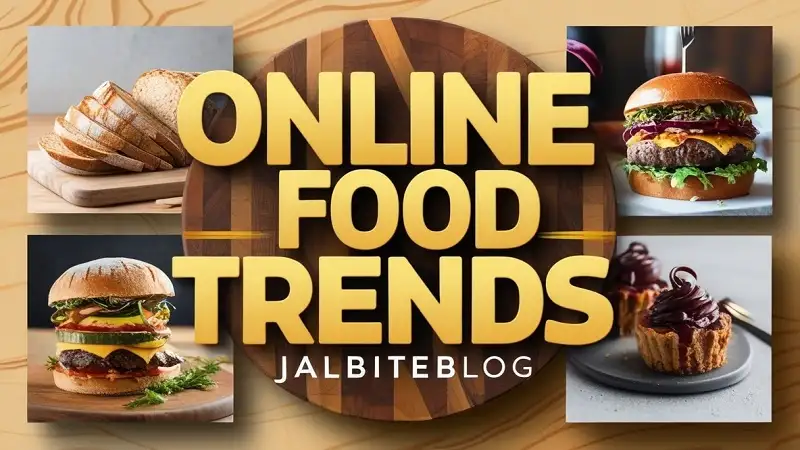The food industry has undergone a massive transformation in the digital age, with online platforms at the heart of this evolution. Online food trends are not only reshaping consumer behavior but also redefining how businesses operate and innovate. From the rise of delivery apps to the explosion of social media-inspired dishes, these trends are driving new experiences, fueling culinary creativity, and pushing the boundaries of convenience. This article explores the major online food trends shaping the way we eat and interact with food in 2025 and beyond.
1. Food Delivery Apps: The Kingpins of Convenience
The emergence of food delivery apps has revolutionized how people access meals. Platforms such as Uber Eats, DoorDash, Zomato, and Swiggy have made it possible to order virtually anything, anytime, anywhere, making them a staple in modern households.
Why Food Delivery Apps Dominate:
- Busy Lifestyles: With people managing packed schedules, food delivery apps offer a hassle-free solution for quick, reliable meals.
- Wide Variety: These platforms give users access to an array of cuisines—from local delicacies to global flavors—all from the comfort of their homes.
- Tech Integration: Real-time order tracking, AI-based recommendations, and cashless payment options enhance the user experience.
Challenges and Opportunities:
Although convenient, food delivery apps face challenges such as high delivery fees, environmental concerns (packaging waste), and ensuring food quality during transit. Many companies are addressing these by introducing reusable packaging, eco-friendly alternatives, and subscription plans for lower fees.
As one of the most prominent online food trends, the dominance of food delivery apps is a testament to the growing consumer demand for ease and speed.
2. Cloud Kitchens: Reinventing the Restaurant Business
Cloud kitchens, also known as ghost kitchens or virtual kitchens, have emerged as a cost-efficient alternative to traditional dining establishments. These kitchens operate solely for online food delivery, with no dine-in services.
The Cloud Kitchen Boom:
- Lower Overheads: Unlike traditional restaurants, cloud kitchens save on real estate and operational costs.
- Menu Versatility: Businesses can experiment with different cuisines and create multiple virtual brands under a single roof.
- Adaptability: Cloud kitchens can quickly pivot to meet changing consumer demands, making them a critical player in online food trends.
Success Stories:
Brands like Rebel Foods and Faasos have embraced the cloud kitchen model, operating multiple successful virtual brands. In the U.S., companies like Kitchen United and CloudKitchens are enabling small businesses to leverage this trend efficiently.
Cloud kitchens are central to online food trends, as they embody the convergence of technology and culinary innovation.
3. The Power of Social Media: Creating Viral Food Moments
Social media platforms like TikTok, Instagram, and YouTube have become powerful tools for shaping food trends. Viral recipes, food challenges, and aesthetically pleasing dishes are now staples in the online food ecosystem.
How Social Media Shapes Food Culture:
- Visual Appeal: Eye-catching presentations and unique plating styles drive shares and engagement.
- Trend Amplification: Viral dishes like dalgona coffee, baked feta pasta, and cloud bread gained global attention within days.
- Influencer Impact: Food influencers and bloggers play a crucial role in popularizing recipes and promoting food brands.
Implications for Businesses:
Restaurants and food brands often adapt their menus to include trending dishes, boosting their visibility and appeal to younger audiences. For instance, Starbucks’ seasonal drinks and McDonald’s collaborations with influencers show how social media can shape menu offerings.
As a driver of online food trends, social media has transformed the food industry into a dynamic, ever-evolving landscape.
4. Healthy Eating Goes Digital: A Conscious Shift
The shift toward healthier eating has become a major online movement, with consumers prioritizing nutritional value, sustainability, and ethical sourcing. Online platforms have made it easier for individuals to explore and adopt healthy food practices.
Popular Healthy Food Trends:
- Plant-Based Diets: Vegan and vegetarian options are now mainstream, with brands offering plant-based meats, dairy-free cheeses, and innovative alternatives.
- Low-Carb and Keto: Diet-specific platforms cater to users following keto, paleo, and low-carb lifestyles.
- Eco-Conscious Choices: Consumers are looking for brands that emphasize sustainable farming, ethical sourcing, and minimal carbon footprints.
Role of Online Tools:
Apps like MyFitnessPal, Yuka, and Cronometer empower users to track their meals, analyze nutritional content, and align their eating habits with their health goals. Online food delivery platforms also cater to health-conscious consumers by offering special categories for organic, gluten-free, or calorie-conscious meals.
Healthy eating, now a cornerstone of online food trends, reflects a growing awareness of the importance of mindful and responsible consumption.
5. DIY Meal Kits: Combining Convenience with Creativity
Meal kit delivery services such as HelloFresh, Blue Apron, and Marley Spoon have grown significantly, offering consumers a middle ground between eating out and cooking from scratch. These kits come with pre-portioned ingredients and detailed recipes, making home cooking accessible and enjoyable.
Why Meal Kits Work:
- Convenience: Meal kits save time on planning and shopping while reducing food waste.
- Skill Development: These kits encourage people to try new recipes and hone their cooking skills.
- Customization: Many meal kits cater to specific dietary preferences, including vegan, keto, and family-friendly options.
Challenges and Innovations:
Despite their appeal, meal kits face criticism for excessive packaging. Companies are addressing this by using biodegradable materials and focusing on sustainability.
Meal kits are a key player in online food trends, catering to consumers who value convenience without compromising on the joy of cooking.
6. AI and Personalization: A Tailored Food Experience
Artificial intelligence (AI) is redefining how consumers discover and interact with food online. From personalized meal plans to AI-powered recipe recommendations, technology is enabling hyper-customized food experiences.
Key Innovations:
- Smart Recommendations: Food delivery apps use AI to suggest dishes based on user preferences, order history, and even weather conditions.
- Recipe Adaptation: Platforms like Tasty and Yummly allow users to modify recipes according to serving sizes, available ingredients, or dietary restrictions.
- Dietary Support: Apps like Noom and Eat This Much create customized meal plans tailored to users’ fitness goals.
AI-driven personalization is one of the most exciting online food trends, bridging the gap between technology and culinary creativity.
7. Hyperlocal Food Delivery: Supporting Local Businesses
Hyperlocal delivery focuses on connecting users with nearby restaurants, home chefs, and grocery stores. This trend emphasizes fast delivery times and fresher food options while supporting local economies.
Why Hyperlocal Delivery Works:
- Speed: Shorter delivery distances ensure quicker service and hotter meals.
- Community-Centric: Consumers appreciate the opportunity to support neighborhood vendors.
- Freshness: Hyperlocal sourcing often means fresher ingredients and a better taste experience.
Notable Examples:
Apps like Dunzo (India) and GoPuff (U.S.) have championed the hyperlocal model, focusing on ultra-fast deliveries and community-driven service.
Hyperlocal delivery represents a significant shift in online food trends, as consumers increasingly seek quality and proximity over big-name brands.
8. Virtual Cooking Classes: Learning from the Comfort of Home
Virtual cooking classes gained massive traction during the pandemic, enabling individuals to learn culinary skills from the comfort of their kitchens. These classes are hosted by chefs, food influencers, and culinary institutions on platforms like Zoom, YouTube, and Instagram.
Why Virtual Cooking Classes Thrive:
- Accessibility: People can participate from anywhere, eliminating geographical barriers.
- Cost-Effectiveness: Virtual classes are often more affordable than in-person workshops.
- Engagement: Interactive elements such as Q&A sessions and live feedback create a sense of community.
Popular Platforms:
MasterClass, Skillshare, and online offerings from culinary schools have tapped into this trend. Influencers like Binging with Babish and Joshua Weissman have also created engaging virtual cooking experiences.
Virtual cooking classes are a vital part of online food trends, empowering people to build their culinary confidence at home.
9. Sustainability in Online Food: A Rising Priority
As consumers grow more eco-conscious, sustainability has become a defining factor in online food trends. Businesses are incorporating practices that minimize environmental impact while meeting consumer expectations.
Key Practices:
- Eco-Friendly Packaging: Many brands are moving toward compostable or reusable materials.
- Locally Sourced Ingredients: Hyperlocal and farm-to-table models reduce transportation emissions.
- Food Waste Reduction: Platforms like Too Good To Go help redirect surplus food to consumers at discounted rates.
Sustainability is not just a buzzword but a vital component of online food trends, influencing everything from packaging to sourcing.
10. The Food Metaverse: A Digital Dining Revolution
The concept of a food metaverse—a virtual space where users can explore, interact with, and even taste food digitally—is becoming a reality. Virtual restaurants, gamified food experiences, and blockchain-based food tracking are just the beginning.
What the Food Metaverse Offers:
- Immersive Dining Experiences: Virtual reality (VR) allows users to “dine” in exotic locations or themed environments.
- Digital Collectibles: NFTs featuring recipes, exclusive menus, or limited-edition items are gaining popularity.
- Transparency: Blockchain technology ensures transparency in the supply chain, building consumer trust.
The food metaverse represents the future of online food trends, merging technology, entertainment, and gastronomy.
Conclusion: The Ever-Evolving World of Online Food Trends
Online food trends are reshaping the culinary landscape, driven by convenience, innovation, and consumer demand. From food delivery apps and cloud kitchens to AI-powered personalization and sustainability efforts, these trends highlight the dynamic nature of the food industry.
For businesses, adapting to these trends is essential to stay competitive in the fast-paced digital world. For consumers, the possibilities are endless, offering everything from healthy eating solutions to immersive food experiences.
Stay tuned to JalbiteBlog for more updates on the exciting evolution of online food trends and how they continue to redefine the way we eat, cook, and connect through food. Read More LifeJoyHub.




